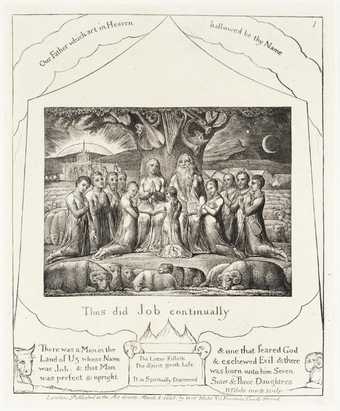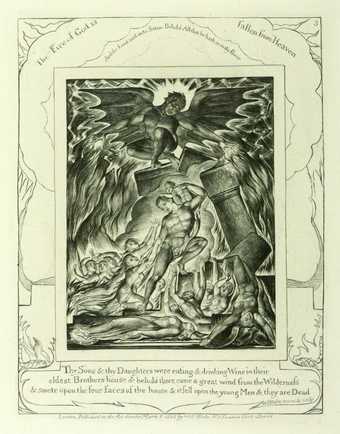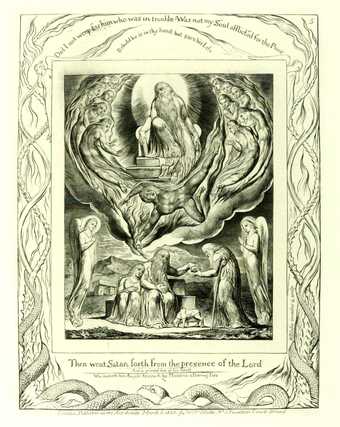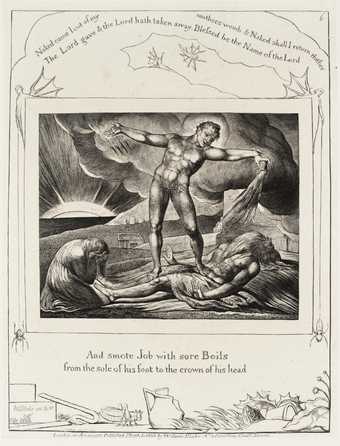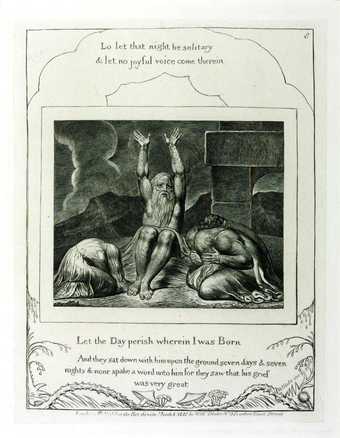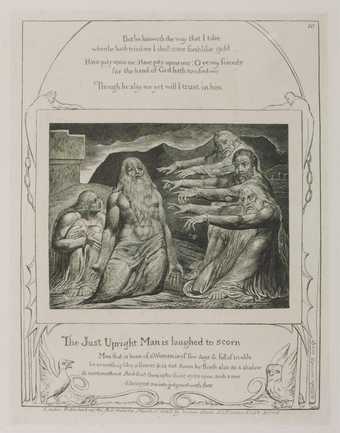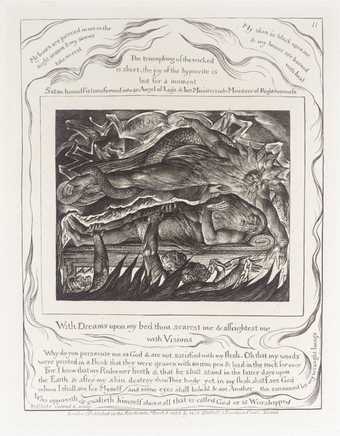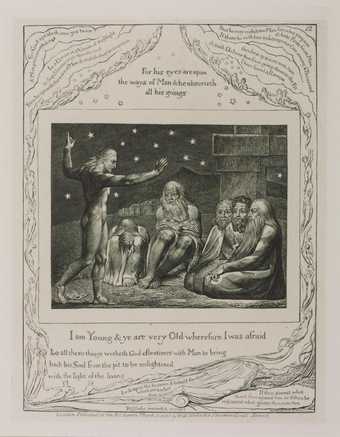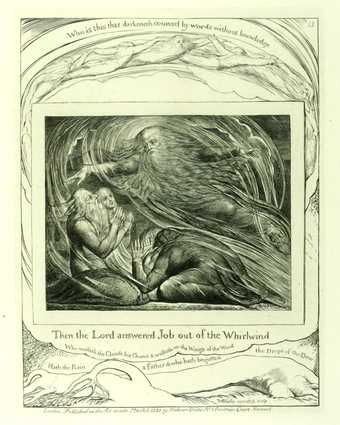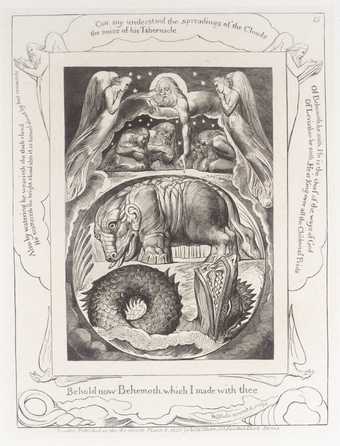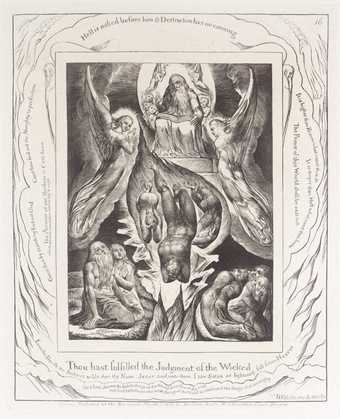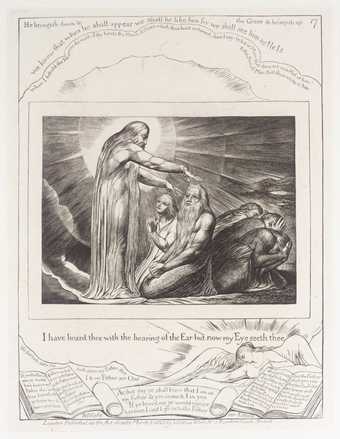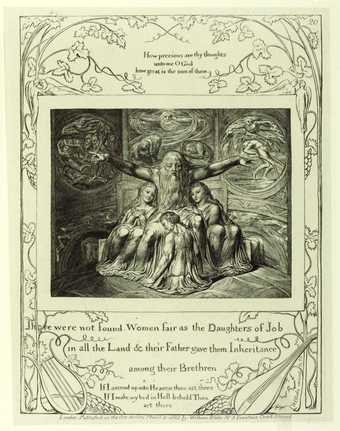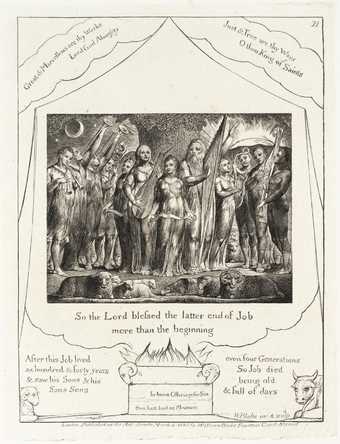
In Tate Britain
Prints and Drawings Room
View by appointment- Artist
- William Blake 1757–1827
- Medium
- Line engraving on paper
- Dimensions
- Image: 198 × 150 mm
- Collection
- Tate
- Acquisition
- Purchased with the assistance of a special grant from the National Gallery and donations from the Art Fund, Lord Duveen and others, and presented through the Art Fund 1919
- Reference
- A00029
Display caption
This is plate 18 of the set of twenty-one engraved illustrations to the 'Book of Job'. They were commissioned by Blake's friend, the artist John Linnell (1792-1882) and Blake worked on them from 1823 to 1825. We know from Linnell that the plates for this series were 'cut with the graver entirely on copper without the aid of [etching acid]'. The effects of darkness and light achieved by this method, combined with the recurring energy of pure line, are always appropriate to the subject. In this sense of unity, the 'Job' series ranks among Blake's supreme achievements as a printmaker. The burin and the palette seen in the margin next to an open bible link the artist with Christ's work as a preacher.
Gallery label, August 2004
Does this text contain inaccurate information or language that you feel we should improve or change? We would like to hear from you.
Catalogue entry
A00029 [from] Illustrations to The Book of Job: Engravings
1823–6/1874 [A00012-A00032; T05845; complete]
A 00012–32 /-
Twenty-two line engravings on india paper laid on drawing paper approx. 510×345 (20×13 1/2)
Purchased with the assistance of a special grant from the National Gallery and donations from the National Art-Collections Fund, Lord Duveen and others, and presented through the National Art-Collections Fund 1919
PROVENANCE John Linnell; his heirs, sold Christie's 15 March 1918 (183) £33.12.0.bt Martin for the donors
LITERATURE Gilchrist 1863, 1, pp.283–4, 297; Wicksteed 1910 and 1924; Russell Engravings 1912, 102–15 no.33: Keynes Bibliography 1921, pp.179–82 no.55: Binyon and Keynes 1935, series repr. vol.VI; Keynes Engravings 1950, pp.16–17, series repr.pls. 42–68; Keynes Writings 1957, pp.869–70, 872, 874, 876–7; S. Foster Damon, Blake's Job 1966, series repr.; Bentley Blake Records 1969, pp.234 n.i, 277–397 passim, 586–605; Andrew Wright Blake's Job: A Commentary 1972, series repr.; Lindberg 1973, pp.24–32, 40–52, 167–76, 183–352 nos.0A–21A, series repr.; Bentley Blake Books 1977, pp.517–24 no.421; Bindman Graphic Works 1978, pp.486–7 nos.625–46, series repr.; Mitchell 1978, pp.41–2; Essick Printmaker 1981, pp.92, 105, 220, 234–50, 252; Robert N. Essick, ‘Blake's Engravings to the Book of Job; An Essay on their Graphic Form with a Catalogue of their States and Printings’ in David Bindman, ed., William Blake's Illustrations of the Book of Job 1987, pp.35–101.
John Linnell, who had commissioned the second set of watercolour illustrations to the Book of Job in 1821, entered into a formal agreement with Blake for the engravings on 25 March 1823: Linnell was to pay Blake £5 a plate or £100 for the set, and in addition he agreed to give Blake an extra £100 if the profits of the work made this possible. The agreement was for twenty engravings though in the event twenty-one subjects were engraved together with a title-page. On 5 March 1825 Linnell went with Blake to the printer J. Lahee to see proofs being taken. The series is dated 8 March 1825 but the final engravings do not seem actually to have been ready until the end of March 1826 (Bentley 1969, pp.277, 300 and 327). At this time 215 sets of engravings marked ‘Proof’ were issued; these should be distinguished from the working proofs, on some of which Blake tried out designs for the borders. The word ‘Proof’ was then deleted (traces can be seen on A00013) and a further 100 sets were printed on drawing paper. According to John Linnell Jr, writing to Bernard Quaritch on 6 May 1892, Linnell, after the 1826 printing, ‘put the plates away, & they were never again used after this time until the year 1874. At this time my father...had one hundred copies printed from the plates upon India paper’. Although the distinctive cover is now missing, it seems that the Tate Gallery's copies of the engravings are from this 1874 printing. The original plates were given by Herbert Linnell to the British Museum Print Room on 28 May 1919.
Each engraving is inscribed ‘W Blake inv. & sculp’. In addition each is inscribed in the lower margin with variations of the text ‘London. Published as the Act directs March 8:1825 by William Blake No3 Fountain Court Strand’; the first actual design (A00012) is mistakenly dated with the year 1828 and ‘Willm’ is sometimes substituted for ‘William’, while the punctuation is also slightly varied.
More importantly, the borders of each design bear a number of inscriptions taken from the Bible or with variations of biblical texts. These add a verbal gloss to the designs which in themselves embody Blake's critical reaction to the original story as set out in the Old Testament. The fullest analysis is in Lindberg though Wicksteed, Damon 1966 and Wright also contain full commentaries. Blake's interpretation of his text is only given in summary form in this catalogue.
These engravings were formerly inventoried as nos.3372 i–xxii. The new inventory numbers omit the title-page.
A00029 Job's Sacrifice
Line engraving 198×150 (7 13/16×5 7/8); platemark 218×171 (8 5/8×6 3/4)
Inscribed ‘WBlake inv & sculpt’ b.r., ‘London Published as the Act directs March 8:1825 by Will Blake No3 Fountain Court Strand’ below, ‘18’ t.r., and with texts given below
Illustration no.18: Job, xlii, 8–10. Blake's main text is ‘and my Servant Job shall pray for you’, that is, his friends (Job, lxii, 8). The consequences are given in the two other main quotations: ‘Also the Lord accepted Job’ (Job, lxii, 9) and ‘And the Lord turned the captivity of Job when he prayed for his Friends’ (Job, lxii, 10). The moral is pointed by a long quotation from Matthew, v, 44–5, 48: ‘I say unto you/ Love your Enemies bless them/that curse you/do good to them/that hate you & pray for them/that despitefull[y]/use you & perse/cute you/That you may be/the children of/your Father which/is in heaven, for he maketh his Sun to shine on the E/vil & the Good &/sendeth rain on/the Just & the Unjust/Be ye therefore/perfect as your Fa/ther which is in heaven is perfect’.
Job stands in front of the altar in the pose of the crucified. The composition is based on that of ‘Noah and the Rainbow, “The Covenant”’, painted c.1803–5 for Thomas Butts (Houghton Library, Harvard University, Cambridge, Mass.; Butlin 1981, no.437, pl.514). In this, as in the engraving and the preliminary Linnell watercolour and Fitzwilliam Museum pencil sketch, the main figure is seen from behind, though in the Butts watercolour he faces the viewer.
Published in:
Martin Butlin, William Blake 1757-1827, Tate Gallery Collections, V, London 1990
Explore
- objects(23,571)
-
- reading, writing, printed matter(5,159)
-
- book, ‘Bible’(19)
- religious and ceremonial(1,733)
-
- altar(79)
- actions: postures and motions(9,111)
-
- arm / arms raised(839)
- kneeling(502)
- Job(24)
- Job, chapter 42(5)
- inscriptions(6,664)
-
- caption(358)
- printed text(1,138)
- quotation(297)
You might like
-
William Blake Job and his Family
1828, reprinted 1874 -
William Blake Satan before the Throne of God
1825, reprinted 1874 -
William Blake Job’s Sons and Daughters Overwhelmed by Satan
1825, reprinted 1874 -
William Blake Satan Going Forth from the Presence of the Lord, and Job’s Charity
1825, reprinted 1874 -
William Blake Satan Smiting Job with Sore Boils
1825, reprinted 1874 -
William Blake Job’s Despair
1825, reprinted 1874 -
William Blake Job Rebuked by his Friends
1825, reprinted 1874 -
William Blake Job’s Evil Dreams
1825, reprinted 1874 -
William Blake The Wrath of Elihu
1825, reprinted 1874 -
William Blake The Lord Answering Job out of the Whirlwind
1825, reprinted 1874 -
William Blake Behemoth and Leviathan
1825, reprinted 1874 -
William Blake The Fall of Satan
1825, reprinted 1874 -
William Blake The Vision of Christ
1825, reprinted 1874 -
William Blake Job and his Daughters
1825, reprinted 1874 -
William Blake Job and his Family Restored to Prosperity
1825, reprinted 1874

